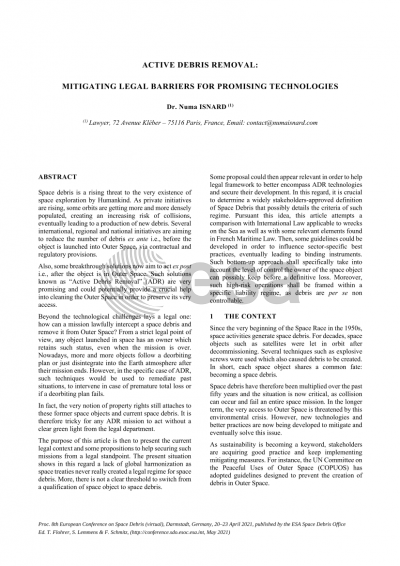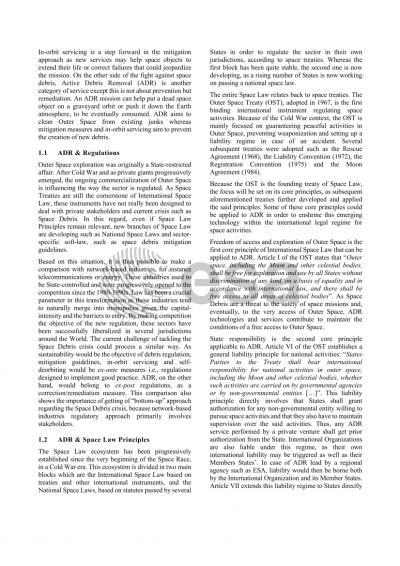Document details

Abstract
Space debris is a rising threat to the very existence of space exploration by Humankind. As private initiatives are rising, some orbits are getting more and more densely populated, creating an increasing risk of collisions, eventually leading to a production of new debris. Several international, regional and national initiatives are aiming to reduce the number of debris ab initio i.e., before the object is launched into Outer Space, via contractual and regulatory provisions.
Also, some breakthrough solutions now aim to act ex post i.e., after the object is in Outer Space. Such solutions known as “Active Debris Removal” (ADR) are very promising and could potentially provide a crucial help into cleaning the Outer Space to preserve its very access.
Beyond the technological challenges lays a legal one: how can a mission lawfully intercept a debris and remove it from Outer Space? From a strict legal point of view, any object launched in space has an owner which retains such status, even when the mission is over. Nowadays, more and more objects follow a deorbiting plan or just disintegrate into the atmosphere. However, in the specific case of ADR, such techniques would be used to remediate past situations, to intervene in case of premature total loss or if a deorbiting plan fails.
In fact, the very notion of property rights still attaches to these objects and it is therefore tricky for any ADR mission to act without a clear green light from the legal department.
The purpose of this intervention is then to present the current legal context and some propositions to help securing such missions from a legal standpoint. The present situation shows in this regard a lack of global harmonization as space treaties never really created a legal regime for space debris. More, there is not a clear threshold to switch from a qualification of space object to space debris.
Some proposal could then appear relevant in order to help legal framework to better encompass ADR technologies and secure their development. In this regard, it is crucial to determine a widely stakeholders-approved definition of space debris that possibly details the criteria of such regime. Pursuant this idea, this presentation will show a comparison with International Law applicable to wrecks on the Sea as well as with some relevant elements found in French Maritime Law. Based on this comparison, some guidelines could be developed in order to influence sector-specific best practices, eventually leading to binding instruments. Such bottom-up approach shall specifically take into account the level of control the owner of the space object can possibly keep before a definitive loss. Moreover, such high-risk operations shall be framed within a specific liability regime, as debris are per se non controllable.
Preview






